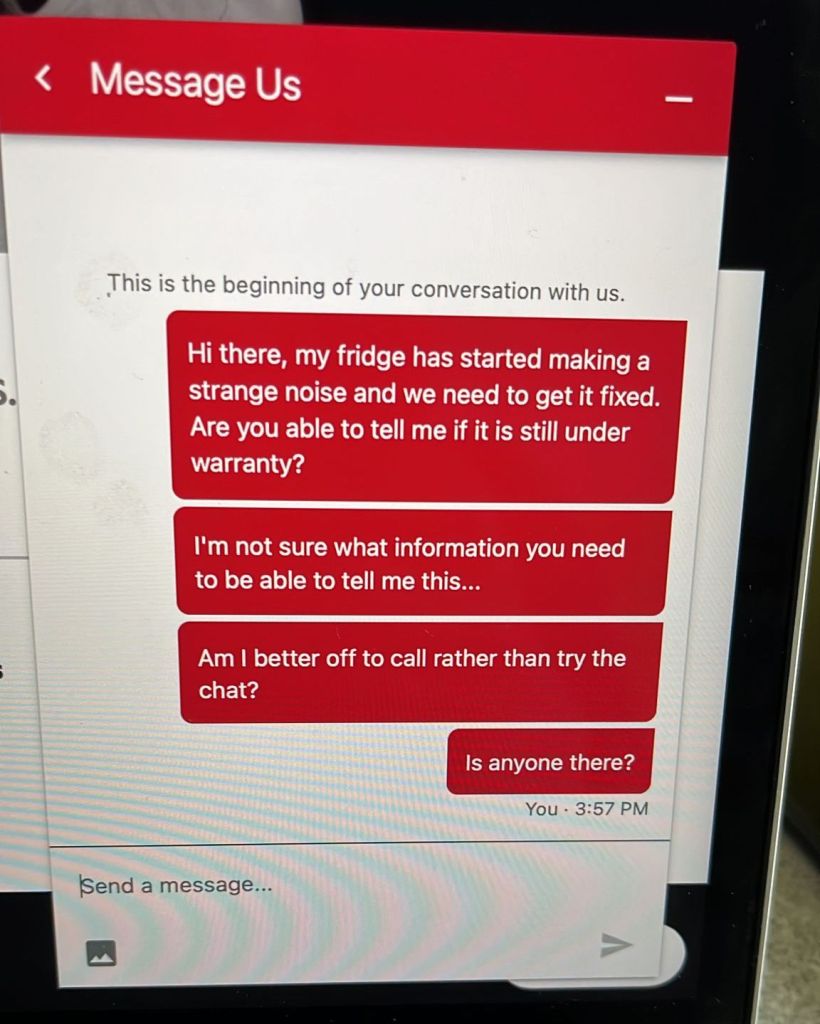You’re reading CX Stories, a newsletter about customer experience innovation. If you want to join the 4000+ lovely people who receive it every month, just enter your email address below.
When my Mum was very ill, I needed to know quickly if I could drive her car.
So, on the move, I phoned my insurance company.
Faced with the usual smorgasbord of options, I tapped what I thought was the right combination of numbers – one for this, two for that – and waited. Within seconds, I was greeted with a friendly, automated voice:
‘You can do that on our website’. Goodbye!’
So, I tried again. A different combination, the same result.
And again.
And again.
Finally, I got out of the mobile escape room and was placed on hold to speak to someone. At regular intervals, the dreary music was interrupted with a cheery:
‘Did you know you can do most things on our website?’
YES I KNOW THAT BECAUSE IT’S 2023 AND I’M AWARE OF THE EXISTENCE OF THE INTERNET I’VE CLEARLY CHOSEN TO PHONE YOU FOR A REASON SO WILL YOU PLEASE JUST PICK UP THE PHONE
Ahem.
Eventually, someone answered.
‘Hi, I need to know if I’m insured to drive someone else’s car’
‘You know this information is in your policy document?’
(Rubs forehead, takes deep breath)
‘Yes but as I’m a normal human being, I don’t carry my car insurance policy document around with me all day’
(Reader, I didn’t actually say that, but it’s what I was thinking. I actually said:)
‘I don’t have my policy document with me;
‘Ok. Yes, you can drive it’.
The total experience of trying to answer this simple question took fifteen minutes. The total time to actually answer my question once I’d got through was 15 seconds. Imagine how good that experience could have been if they’d just picked up the phone quickly and answered my question without the telling off?
I thought about this experience recently when reading BT’s ‘Autonomous Customer’ report, looking at how customers think about different ways of contacting organisations.
This graph stood out for me:

It feels like there’s an inconvenient truth in here: sometimes, customers still like to use the phone to speak to organisations. Yet organisations are investing in all the other ways instead, trying to actively push customers towards them.
Now, you could argue that it shows people are having to use the phone because the other channels still aren’t good enough – the highest figure is still only 49% ‘very satisfied’. But I interpret this slide as showing that customers are, overall, more satisfied with the other channels than a phone call or an email, but still use them anyway.
That means that, on those occasions, they’re probably phoning because something big or important is happening, a moment that matters, something they really need help with. Yet it’s at precisely at this moment of most need that organisations are providing their worst service, at the time when they could make a real difference to someone’s life, at a time when they could really deepen the relationship they have with a customer.
That being the case, it does beg the question as to why organisations persist with these hated – and much mocked – behaviours: The ‘press option one’. The ‘you can do that online’. The ‘no reply’ email address. Or the ‘our phone lines are busy at the moment, why not try chat instead?’, the prompt for the webchat below that, after three hours, wasn’t really making the progress we’d hoped.

The answer, of course, is the illusion of a silver bullet for organisations and leaders who have hastily built their future business cases around low-cost-to-serve models. They now see the world through sunk-loss-tinted glasses, not wanting to admit that maybe, those pesky customers, with their ‘preferences’ and ‘opinions’, want to be served another way.
The irony in this is that, by trying to force the issue, it creates greater dissatisfaction and higher failure demand. This brings extra cost into the business and loses revenue as people take their decisions elsewhere, when answering the phone and dealing with the problem quickly might well be the most efficient way.
As Steve Jobs, Henry Ford, and a hundred other quotable innovators have paraphrased, it’s right to try and lead your customers to new ideas and innovations, to new ways of working that can be of benefit to all. But it’s also right to stay connected to what matters, to their habits and behaviours, to understand the things that won’t change, however much the finance department wishes they would.
Creating a truly great customer experience is a delicate balancing act, staying ahead of the competition whilst not leaving your customers behind. Because if you do, there’s this new thing called the internet out there that makes it very easy for them to go elsewhere.
Thanks for reading this article, I really hope you enjoyed it. You can subscribe to my monthly newsletter below, and find me in tweet form @johnjsills, in picture form on Instagram @johnjsills, or in work mode at The Foundation or on LinkedIn.